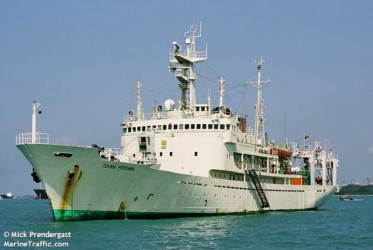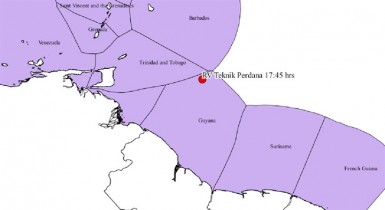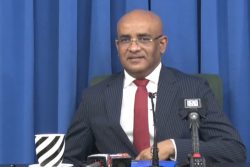A Venezuelan naval vessel on Thursday intercepted a research boat for a US oil explorer in Guyana’s waters and later forced it to the Venezuelan island of Margarita, sparking a strong protest from the Government of Guyana (GoG).
“The GoG is of the firm belief that the actions taken by the Venezuelan navy constitute a serious threat to the peace of the sub-region and the (GoG) therefore strongly condemns these actions,” the Foreign Affairs Ministry said yesterday in a release issued by Ambassador Elisabeth Harper after finding out about the interception, which it said occurred around 16:00 hrs on Thursday.
By the end of yesterday, Caracas accused the vessel of scientific prospecting and exploration of the continental shelf and the seabed of Venezuela.

This case is the most serious diplomatic incident between the two countries in recent years and will be seen as a test of ties been the Ramotar and Maduro administrations. The naval demarche comes just weeks after an official visit by Venezuelan President Nicolas Maduro to Guyana on August 31.
In its statement yesterday, the Foreign Affairs Ministry said that the RV Teknik Perdana, under contract with Anadarko, which has a petroleum prospecting licence to search for hydrocarbons in the Roraima block offshore Guyana, was obstructed by a Venezuelan naval vessel, the Yukuana, while it was conducting surveys in Guyana’s Exclusive Economic Zone (EEZ).
The ministry added that the crew of the RV Teknik Perdana attempted to explain to the crew of the Venezuelan Naval vessel that they were conducting “a multi-beam of the seafloor in Guyana’s exclusive economic zone.” The Venezuelans, however, argued that the vessel was operating “in Venezuela’s exclusive economic zone and instructed that the vessel switch off its engines and shut down its seismic equipment.”
At around 17:45 hrs, the release said, the RV Teknik Perdana, which was then located 10 21.0745 N, 57 31.1057W, was instructed to travel at 5 knots in a westerly direction, and at 20:30 hrs, it was instructed to increase speed to 7 knots and given directions to sail to the island of Margarita in Venezuela. In assessing the situation the Foreign Affairs Ministry said, “It was then clear that the vessel and its crew were not only being escorted out of Guyana’s waters, but were under arrest.”
Stabroek News attempted to find out the whereabouts and status of the crew of the RV Teknik Perdana as of yesterday afternoon from the Ministry of Foreign Affairs. Harper, the ministry’s Director General, however, informed this newspaper that the only person authorized to divulge such information, Foreign Affairs Minister Carolyn Rodrigues-Birkett, was out of the country, and would be back on Monday.
“One point is clear and that is that the RV Teknik Perdana was in Guyana’s waters when this incident took place,” the ministry yesterday insisted, and added that “the (GoG) has expressed to the Government of the Bolivarian Republic of Venezuela its grave concern about the incident involving the RV Teknik Perdana and has requested the immediate release of the vessel and its crew.”
During his visit in August, Maduro committed Venezuela to the peaceful resolution of the controversy, and yesterday the ministry said it “firmly believes that actions taken by the Venezuelan Naval vessel threatens the peace of the sub-region.
But even as the ministry condemned the action, it said that it still “believes in the peaceful resolution of disagreements amongst States,” and expressed intentions to employ such methods to “facilitate a prompt return to the status quo ante.”

During his visit, Maduro and President Donald Ramotar recommitted to the United Nations Good Offices Process in the search for a peaceful and practical settlement of the border controversy. Maduro had said, “In our discussions today we also agreed to renew the Good Offices Process of the United Nations (UN)” ‒ a reference to the mechanism employed under the Geneva Agreement of 1966 to find a means to resolve the Guyana-Venezuela border controversy
He further said, “We want to ratify as well that we are ready to continue working despite the legacy of the border dispute that we have inherited from the empires of the past and we are ready to continue working through the Good Offices of the United Nations organisation considering this as the sole and successful mechanism to allow us to channel our differences using international law.”
‘Official protest’
It is unclear whether Takuba Lodge called in the Venezuelan Ambassador to lodge an official protest over the action by the Venezuelan Navy in what is recognized as Guyana’s EEZ.
However, according to the Venezuelan newspaper El Universal, Caracas yesterday entered an official protest with Guyana, seeking an explanation for the exploring boat’s presence in what it described as the “Venezuelan Atlantic seaboard.”
The report quoted the Venezuelan Ministry of Foreign Affairs as saying that “The Government of the Bolivarian Republic of Venezuela expresses its strong protest to the situation that arose with respect to scientific prospecting and exploration of the continental shelf and the seabed (of Venezuela) , made by the vessel.”
It also added that “the Bolivarian Republic of Venezuela reiterates its commitment to peace and the will not to return to past situations of confrontation with the sister Republic of Guyana , as well as to continue to persevere in the path opened by (late Venezuelan President) Commander Hugo Chavez to promote relations cooperation among peoples and strengthen the Latin American and Caribbean integration . “
The report stated that the RV Teknik Perdana would reach its intended berth on Margarita Island today at 6 am.
There was no statement yesterday from the Guyana Defence Force on Venezuela’s actions in Guyana’s waters.
According to the Article 57 of the United Nations Convention on the Law of the Sea (UNCLOS), “The exclusive economic zone (extends) 200 nautical miles from the baselines from which the breadth of the territorial sea is measured.”
Article 2 (1) (a) of the same convention gives the owner of an exclusive economic zone, “sovereign rights for the purpose of exploring and exploiting, conserving and managing the natural resources, whether living or non-living, of the waters superjacent to the seabed and of the seabed and its subsoil, and with regard to other activities for the economic exploitation and exploration of the zone, such as the production of energy from the water, currents and winds.”
According to the provisions of this convention, the RV Teknik Perdana, having full permission from the government of Guyana, was carrying out its activities in Guyana’s waters and the Venezuelan Naval vessel therefore, had no authority to operate within those waters without the permission of the ministry, and furthermore, to demand that the exploration vessel cease its activities and accompany it to Margarita.
Recognising this fact, the ministry in its statement said, that “the Venezuelan naval vessel, the agents of Venezuela, its Government nor any other State has the authority to exercise any action in Guyana’s territorial waters, it continental shelf or its exclusive economic zones without its express consent.”
Domestic pressure
Political analysts have noted that the Maduro administration is under severe domestic pressure and weak. The analysts say elements in his government may well seek to exploit the border controversy for domestic purposes. It is however more likely, analysts say, that the Venezuelan military and right wing sections of the political establishment will seek to use the turmoil in Venezuela to rekindle domestic interest in the border controversy. Under the late Venezuelan president Hugo Chavez, who passed away in March this year, Caracas had tamped down belligerence surrounding the controversy and it had not been prominent on the agenda between the two countries. In his 2004 visit to Guyana, Chavez had offered conciliatory remarks which were taken to mean that Caracas would not oppose big development projects in the Essequibo region.
Further, under Chavez, Guyana became part of the PetroCaribe initiative, which provides the country with oil on concessional terms. Caracas is also taking large amounts of rice from Guyana each year to be offset by the cost of the oil and relations have been generally improved in recent years. However, analysts had warned that with the narrow electoral win of Maduro last year over Henrique Capriles and the domestic pressures on him highlighted by deepening economic woes and food shortages, it would be foolish for Georgetown to believe that there were not significant risks on the horizon.
For these reasons, analysts had criticised Guyana’s low-key response to an Eteringbang intrusion on the day of Maduro’s visit on August 31. Head of the Presidential Secretariat, Dr Roger Luncheon, two weeks after the incident had said that the Venezuelan delegation that crossed into Eteringbang, Cuyuni/Mazaruni last month had offered an apology for the breach in the agreement under which they were allowed to enter the country.
He said, according to the Government Information Agency that the delegation, comprising research students, arrived in Guyana on August 31 and obtained the approval from the relevant authorities. However, the soldiers that were accompanying them were told that they could not disembark their boat and enter the country armed.
“Official sources from the Guyanese authority at the border was that the visitors sought and received permission to engage the members of the Guyanese communities on the border who assumedly, had some relationship with Venezuela whether biological or trading relationship,” the HPS explained.
However, in relation to the soldiers, he said that they were not allowed and as such, their entry constituted a breach in the agreement, GINA related.
“They were not allowed was the official report provided by the Guyanese authorities, and it was as far as the authorities there were concerned, a breach of the agreement, the understanding under which they were allowed to enter Guyana, a breach once drawn to their attention they made the suitable apologies and corrected,” Luncheon said. It was not clear from the GINA press release what form the apology took and who it was made to.
While Luncheon referred to the delegation as research students. The Venezuelan newspaper El Universal described them as members of a group seeking to publicize Caracas’s claim to Essequibo.
The publication quoted Venezuelan Ricardo de Toma as saying: “We came here to carry out a civil exercise of sovereignty, but we do not understand what President (Nicolas) Maduro was doing there [in Guyana].” Maduro was on a visit to Guyana on the same day.
El Universal said de Toma and his colleagues were members of an organisation called ‘My Map of Venezuela also Includes our Essequibo’.
According to the publication, de Toma said that in spite of the mining projects Guyana has been developing in the “Essequibo-disputed area with Venezuela,” plus the granting of oil concessions in the Venezuelan Atlantic front, President Maduro “paid a visit (to Guyana) only to spread an ideological model.”
Observers had said that under no circumstances should Venezuelan military personnel have been allowed to cross the Cuyuni into Guyana on a false pretext.
Historical perspective
In 1899, an arbitration tribunal sitting in Paris handed down an award which fixed the boundary between Venezuela and this country (which was a British colony at the time) that remained unchallenged for more than 60 years.
Following the award a Mixed Boundary Commission was appointed jointly by Venezuela and Britain and between 1901-1905 the boundary was surveyed and marked by this commission.
In 1911, the Venezuelan government published a map which reflected the boundary lines demarcated by the commission, and which was signed by the then Minister of Internal Affairs. A similar map was published by the Venezuelan Government in 1917.
Further, in 1931 Venezuela in conjunction with Britain (for British Guiana) and Brazil carried out surveys on Mount Roraima to determine the specific point where the three borders met. They reached an agreement in 1932 and the tri-junction point was fixed.
However in 1962, Venezuelan Foreign Minister Marcos Falcón Briceño, made a contention to the United Nations Fourth Committee that the Arbitral Award of 1899 was invalid, and argued that the region west of the Essequibo River was Venezuelan territory. The contention was based on a memorandum which had been written by Severo Mallet-Prevost in 1944 alleging that the Paris Award was the result of a secret deal between the Russians and the British and was therefore null and void. Mallet-Prevost had been the Junior Counsel on the team which presented Venezuela’s case before the tribunal in 1899. His memorandum was published in 1949 after his death.
Prior to Guyana obtaining independence in 1966, the Geneva Agreement was signed between Venezuela, the then British Guiana and Britain, setting up a Mixed Commission in the first instance, which sought satisfactory solutions to the controversy which had arisen because of Venezuela’s contention that the 1899 Award was null and void.
Nevertheless, that same year following Guyana’s independence, Venezuela seized Guyana’s portion of Ankoko Island in the Cuyuni River. This action was taken by Venezuela despite the clause in the Geneva Agreement stipulating that no claim or enlargement of an existing claim, aside from what was asserted within the Mixed Commission, would be pursued while the agreement was in force.
Venezuela still occupies Guyana’s part of Ankoko, and since 1966 there have been a number of violations of Guyana’s territorial integrity involving intrusions into its airspace as well as its land space.
In June last year, the Government of Guyana signed an agreement with Anadarko Guyana Company, a wholly owned subsidiary of Anadarko Petroleum Corporation a US based company to undertake exploration in the deep waters of Guyana’s EEZ.
A press release from the Ministry of Natural Resources and the Environment (MNRE) said then that the company sought to engage the Government of Guyana to conduct exploration activities in 2011 and had submitted technical proposals and held a series of discussions with senior government officials including President Ramotar.
According to the press release, the discussions resulted in an agreement to commence studying available data for the concession acreage, which will be referred to as the ‘Roraima Block’ in greater detail with a view to identify leads that could result in prospects favourable for drilling to locate potential resources of petroleum.
Oil exploration in Guyana’s waters has in the past attracted interference by both Caracas and Suriname in the west. Surinamese gunboats chased away an oil rig contracted by CGX in June of 2000, sparking years of dispute until its substantial resolution in Guyana’s favour after it formally went before the International Law of the Sea Tribunal in Hamburg, Germany.









